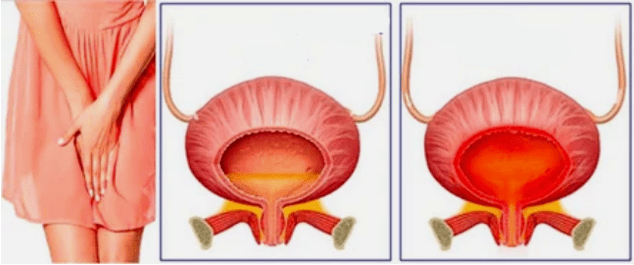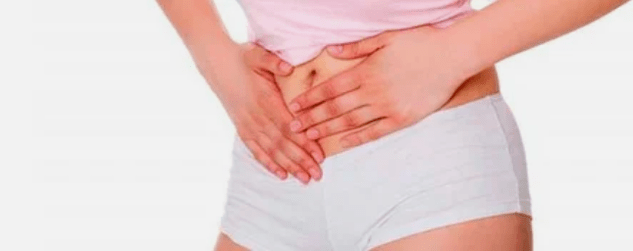Chronic cystitis is a "special" disease that every tenth woman suffers.Often meet new deterioration after 1-2 weeks.After the course of antibiotics.
What is the matter and how to overcome the disease?To get a clear answer to these questions, you need to understand what chronic cystitis provoked and what happens in the bladder.
Chronic cystitis - The truth lies in the cause of inflammation

Chronic cystitis is a collective concept, which is just a result of a series of diseases.At the same time, the inflammatory process develops longer than 2 months and affects not only the mucus bladder (as well as in acute inflammation), but also deep layers.
It is useless to treat the disease exclusively with antibiotics, such as acute inflammation.To mitigate the pain - only to trickle yourself, the consent of temporary relief.Meanwhile, the disease will continue to progress, and sooner or later pain will notice "to reject" life.We offer a rational approach to understanding the disease.
In a chronic inflammatory process, the pathogenic microflora is quickly developed in the bladder.It cannot be just bacteria, but also mushrooms and protozoa and viruses.Therefore, the taking of antibiotics is not always justified.
Important!Treatment of chronic cystitis with drugs from the antibiotics group is recommended only if the urine is revealed in the analysis of sensitive microorganisms.
A patient with chronic cystitis always has a pathology that supports inflammation:
- Leukoplakia from the bladder door (not true!) Or vaginal metaplasia - Chronic Cervatic Congratitica causes benign degeneration of mucosa, which is the result of several acute cystitis or sexual infection, including hidden (ureapmosis, chlamide, etc.);
- Diverticula of the bladder, polyp, urolithiasis - excellent place to spread bacteria and fungi;
- Kidney inflammation, hydronephrosis, renal disease - infection from the kidney with urine constantly enters the bubble;
- The deep arrangement of the urethra revealed during intercourse, - causes postcoitsical cystitis;
- Reduction of local immunological protection - occurs during hormonal failures (insufficient synthesis of estrogen during pregnancy, during menopause, with the pathology of ovarian), genital disease, melitus diabetes;
- Chronic foci infections (caries, chronic tonsilitis, sinusitis, etc.) - The pathogen is spreading in blood.
Important! These diseases are the right cause of chronic cystitis.Therefore, the disease should be considered together with the causal pathology.For example, the correct diagnosis sounds like this: "Bubble polyposis. Chronic bacterial cystitis."
The worsening of chronic cystitis can be provoked:
- a small amount of drunk water;
- Entering spicy food, alcohol;
- Hypothermia, acute respiratory infections;
- "Greenhouse" effect - wearing thick synthetic bedding, narrow jeans;
- Basic non-compliance with personal hygiene.
Symptoms of chronic cystitis in a woman
Chronic cystitis gives less pronounced symptoms of acute inflammation.Under the weight of clinical symptoms and frequency relapse, the following options for the course of chronic cystitis are characterized:
- Right latent - absence of complaints and laboratory changes in urine, diagnosis is only confirmed by endoscopic examination;
- Latent with rare relapse - Acute image of cystitis occurs not more than 1 times a year;
- Latent with frequent relapse - worsens 2 or more times in the year;
- Controversial current inflammation, which has been confirmed by the laboratory and endoscopic;
- Interstitals - expressed symptoms, persistent pain syndrome.
Important!Chronic cystitis from chronic pelvic pain should be distinguished.In the last pathology in most cases, there are no changes in urine analysis, there is no endoscopic confirmation of inflammation.
Changes in bladder walls differ from catharhal, ulcerat and necrotic.
Symptomatic image of chronic cystitis:
- The pain is almost constant pain pain in the lower abdomen (above pubis), which grows when filling the bladder and periodic painful sharp.Silence during urination - before, after, but more often at the end of the bladder discharge.
- Frequent Mokrevina - In the examinations of chronic cystitis, for women notes that they often do not allow you to do without toilet, finishing the release of a small amount of urine and the feeling of incomplete discharge.There is often Nicturia (campaigns in the toilet in night) and stressful urinary incontinence.
- Changes in urine - with ulcerative lesions and early necrotic process, blood appears in urine.
Important!Unlike urethritis, pain in chronic cystitis is not always associated with the act of urinating.
If the symptoms of chronic cystitis in women have worsened after treatment (after 1-2 weeks), inflammation is activated by activating one type of microorganisms.Relapse, which originated a few weeks after therapy, indicates a repeated infection to another type of pathogen.Together with the signs of chronic cystitis, women also notice the symptoms of basic disease - discharge from the vagina with gynecological pathology, pain in the lower back during the kidney pathology.
Important!The urine analysis in chronic cystitis does not always reveal the signs of inflammation and reveals the pathogen.Only the study is guaranteed to confirm the diagnosis is cystoscopy.Sometimes urography is needed.
How to properly treat chronic cystitis?

Most women who suffer from chronic cystitis attempted themselves antibiotics themselves and homeopathic drugs know what therapeutic injection in the bubble and ionophoresis.And then why does it seem like properly prescribed, a complex treatment does not help?The answer is simple - the cause of inflammation is not removed.The effective treatment of chronic cystitis is performed in the following areas:
- Elimination of causal pathology
Depending on the diagnosis, the urethra (plastic) is performed with an abnormal deployment, laser ablation of leukoplakia and polyps, etc.Almost all surgery are carried out through the urethra, do not leave scars on the skin.Patient performs spinal or intravenous anesthesia.
Trans urethral operations (for example, removing stones) are often carried out during cystoscopy.Reviews of women about the treatment of chronic cystitis often indicate the painfulness of the endoscopic examination.Cystoscopy should be performed with anesthesia so that the patient does not experience pain.After transuretral operations, the woman is in hospital for only 1 day, second day, she can go to work.
- Fight against infection
Depending on the type of pathogen detected, patients are prescribed by the course of antibiotics, antivirus or antifungal funds.With bacterial cystitis, medications with bactericide (not bacteriostatic!) Action with a 7-10 day course are prescribed.
- Treatment of symptoms of chronic cystitis in women
The most common NSAID is used to quickly leveling pain syndrome.After 2-3 weeks.NSAID course, the effect lasts up to 3 months. At the same time, antihistamines are prescribed.
- Immune stimulation
At the same time with antibiotic therapy, the use of immunity can replace preventive courses in the next 6 months.
- Elimination of tissue hypoxia
In order to improve the mucousic bubble nutrition and prevent the formation of adhesions, antitints are prescribed.
Preparations that return microcirculation and have immunity effects are also widely used for prostatitis in men and are prescribed for chronic cystitis in women.
- Prevention of Epithelia Replacement
Hormone drugs were actively used for this purpose.Estrogen and progesterone speed up the development of a protective layer on the mucous membrane.Widely used Divin medications are produced in tablets and candles.
- Local therapy
For local exposure to the inflammatory process, they resort to installations (injections) in the bubble dioxidine, heparin, colloidal silver solution (fighting bacteria, viruses, simplest and fungi).However, this treatment is resorted only to extreme cases to exclude infection.
- Physiotherapy
Physiotherapy - Drug Electrophoresis, Ultrasound, Laser treatment, Electric stimulation, magnetotherapy - prevent further replacement of the bladder epithelium and have the effect of resorption.Drug treatment actively complements physiotherapy exercises to normalize blood circulation and strengthen muscle bowls.
- Treatment to folk drugs
It is possible to treat chronic cystitis at home with baths and decktick healing herbs only with the approval of doctors attending!Most of them have diuretic and antiseptic effect.In addition, the stomach activates the regeneration of tissues, the fight against fungal infection, chamomile and ivy eliminate muscle cramps (affecting pain), ehinacea has an antivirus effect.Treatment of medicinal herbs takes at least a month, the best effect is achieved by a combination of several plants.
Important!In chronic cystitis, it is necessary to consume sufficient water, exclude sharp, salty dishes, smoked meats and foods containing preservatives and chemical colors from the diet.
What is the forecast?
The duration of treatment and prognosis of the disease depends on the degree of damage to the bubble epithelium, the nature of the same time pathology and the state of immunity.To prevent relapse, doctors advise comply with the following recommendations:
- 10 days.Drink plant decoction;
- The next 10 days is an antibiotic;
- 10 more days.Decociation of other medicinal grass.
A similar scheme used for 3-6 months.After the main course of treatment, practically eliminates the deterioration of chronic cystitis.
The most unfavorable forecast for forming the scars in the bladder and urethra.In such cases, there is a need for surgical excision of connective tissue.
It should also remember that chaotic drugs without a recipe without a prescription can eliminate acute symptoms, but will not return the mucus bladder and will not release the causal disease.Only a doctor, who has a clear idea of the cause of the disease, will individually prescribe an effective treatment scheme and will help solve exhausting symptoms of chronic cystitis!
























